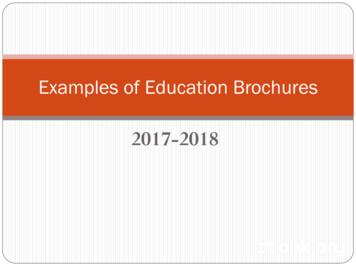COURSE BROCHURE - Ifmcinstitute
IFMC INSTITUTECOURSE BROCHUREIFMC BRANCHESLAJPAT NAGAR(DELHI)VAISHALIGHAZIABADNORTH CAMPUS(DELHI)E-90,FIRST FLOOR,LAJPAT NAGAR 1,NEW DELHI - 110024PLOT No. 3, 2ND FLOOR,RELIANCE PLAZA 2,MAIN MARKETSECTOR 4, VAISHALI,GHAZIABAD - 201012SHOP No. 3, VIJAYNAGAR, HUDSONLANE, KINGSWAYCAMP, OPPOSITENDPL OFFICE,NEAR SHIV MANDIR,NEW DELHI - 110009PH: 91-981-021-6889 91-981-026-0089PH: 91-120-437-7006PH: 91-981-026-0089NOIDABASEMENT,MAAN SINGH COMPLEX,SECTOR 15 MAIN ROAD,NEXT TO BHAGMALCOMPLEX, NEAR McDONALD SECTOR 16,NOIDA – 201301PH: 91-981-021-6889
CONTENTSAdvance Diploma in Financial Markets (ADFM) . 3Unique Feature of ADFM . 4What Will You Get? . 4Certifications . 4Detail Curriculum . 5Module 1: Capital Market & its Operation (NISM Certification) . 5Module 2: Derivatives Market & its Operations (NISM Certification) . 5Module 3: Commodity Market (NCFM Certification) . 5Module 4: Currency Market (NISM Certification) . 5Module 5: Technical Analysis and its Application (NCFM Certification) . 6Module 6: Option Strategy (NCFM Certification) . 9Module 7: Fundamental Analysis (NCFM Certification). 10Module 8: Investment Advisor (NISM Certification). 12Module 9: Security Operation and Risk Management (NISM Certification). 12Module 10: Research Analyst Certification (NISM Certification). 12Who Should Do This Course? . 14Career Opportunity . 14Admission Criteria And Eligibility: . 14ONLINE COURSES . 15IFMC YOUTUBE CHANNEL . 16Page 2
Advance Diploma in Financial Markets (ADFM)About “ADFM” Advance Diploma in financial markets, a one year programmespecially designed for all students and professionals who wish to specialize in thestock market, Share market course. It is an Advance course in the stock market. This100% skill oriented and 100% Job oriented programme in Share market and is oneof the programmes for all those who wish to do specialization in Bankingcourses, Stock Market and Share Market coursesEven those students who have done MBA Finance, Marketing and even HR or anyother field can do Specialization in share market which is the most upcoming sector.As per NSE, there are going to be 1 crore plus jobs in this field in next decade.ADFM is a short-term course in the stock market with 100% Job guarantee inbroking houses, financial institutions and banking industry. One can get stable,paying and white collar jobs in this field. This is a highly reputed sector andpersonnel’s working in Stock Market, Share market and Banking are consideredhighly skilful and knowledgeableThe module is based on Theory as well as practical. The course includes Capital,derivatives, options, commodity, and currency market operations, risk managementin broking industry, investment advisor, technical analysis, fundamental analysis andresearch, option strategy analyst in financial institutions and banks.This is a One-year career-oriented course in the financial market as a part of BFSIsegment. NSE courses, SEBI courses, and BSE certification courses are now inhuge demand in broking houses, stock market advisory companies, KPO, andinvestment advisory companies.This course is divided into 11 modules, in which 10 modules including preparationand certification of NSE and SEBI certificates theoretical and practical on livesoftware’s used in stock market trading courses. Apart from this 11th module is ofinternship or on the job training.APPLY NOW FOR ADFMPage 3
Unique Feature of ADFM 100% Job oriented course along with graduationA complete and comprehensive programme for all those who wish to specializein stock marketA great add-on course along with Graduation, MBAIndustry recognized programmeBased on theory as well as practical for complete knowledgeYou enter the industry completely trained and fitFaculty with 15 years of experience in Teaching and tradingPractice on Live MarketsWorkshops and other programmes and meet with industry experts.Become 100% confident to trade and earn5 tier exposure Faculty, Practical Faculty, Older investor and Trader, ResearchTeam, group discussion, Reliance SecuritiesWhat Will You Get? NCFM Capital Market Module certificationNISM Equity Derivative Market Module & NCFM Derivative Market DealersModuleNISM Currency Derivative Market Module certificationNCFM Commodity Market certificationNCFM Option strategy CertificationNCFM Technical Analysis CertificationNCFM Fundamental analysisNISM Research analyst certificateNISM Securities operation and risk managementNISM Investment advisorIFMC Certification-ADVANCE DIPLOMA IN FINANCIAL MARKETSCertifications 5 Certificates of NISM Modules5 Certificates of NCFM ModulesAdvance Diploma Certification From IFMC*NCFM and NISM Certificates are subjected to appearance for the exam at the NSECenter. You get 100% preparation at the branchNote: Examination fee of NSE & SEBI certification is extra as given Program Fee – Rs 1,25,000Program Duration 1 YearAPPLY NOW FOR ADFMPage 4
Detail CurriculumModule 1: Capital Market & its Operation (NISM Certification) Basic knowledge of capital market (Primary Market & secondary Market)Major Market ParticipantsMajor exchanges and indicesLegal Framework and regulationsTrading and Trading MembershipClearing and Settlement ProcessFundamental Valuation concepts Glimpse of various trading software (ODIN,NEAT, NOW) Practical training of market operationsPractical Classes daily from 10.00am-03.30pm (live trading and methodology)Online Mock test (500 Question & answer test series) of NCFM Capital marketmoduleModule 2: Derivatives Market & its Operations (NISM Certification) Introduction to Derivatives, Type of derivative contractsUnderstanding of future, forward, option and SWAPFuture contracts, Mechanism & pricing of Forward contractsUnderstanding of Options and it’s (call & put)Trading, Clearing, and Settlement, Risk Management in DerivativesRegulatory Frame WorkAccounting of DerivativesPractical Classes of 10 hours (live trading and methodology (Futures & Options)Online Mock test (1000 Question & answer test series) of NISM Derivativemarket moduleModule 3: Commodity Market (NCFM Certification) Understanding Commodity MarketLive Trading in Commodities- MCX and NCDEXInternational commodity Vs Domestic CommodityModule 4: Currency Market (NISM Certification) Currency Derivative and its HistoryForward, Future and Options of currency derivativeTrading, clearing, settlement & Risk Management of currency futuresDifferent Strategy Use for Currency Derivative TradingLive Trading practices (2 Hours) in currency derivative segmentOnline Mock test (800 Question & answer test series) of NISM series1Page 5
Module 5: Technical Analysis and its Application (NCFM Certification)Introduction to Technical AnalysisWhat is technical analysis?The basis of technical analysisDifference between technical vs. fundamental analysisType of ChartsIntroduction to chartThe various types of price charts Line chart Bar chart Candlestick chart Kagi chart Point & Figure chart Renko chart Three Line Break chartTrend lines What is the purpose of drawing trend lines?How to plot trend linesCandlestick StudyOne candlestick pattern DojiHammer / Hanging ManInverted Hammer / Shooting StarSpinning TopMarubozuDouble candlestick pattern Bullish/Bearish EngulfBullish/Bearish HaramiPiercing pattern /Dark cloud coverTweezer Top & BottomPage 6
Triple candlestick pattern Morning star /Evening starThree white shoulders / Three black crowsAbandoned body (Bullish & Bearish)Tasuki Gap (Bullish & Bearish)Five candlestick pattern Rising three methods & falling three methodsSupport & ResistanceWhat is Support?What is Resistance?Change of support to resistance and vice versaCharts patterns and their studyFour stages: Accumulation, Mark-up, Distribution and Panic liquidationChart patterns: Head & Shoulder Inverted Head & Shoulder Double top/bottom Flag & Pennant Symmetrical, Ascending, Descending Triangles Wedge Patterns Rounding top/bottom Cup & Handle Rectangles Bullish/Bearish Triple top/bottomGaps & Gaps AnalysisTypes of Gaps: Common gap Breakaway gap Runaway gap Exhaustion gap Island clusterOscillators & indicatorsWhat does a technical indicator offer?Why use indicators?Types of indicators: Leading indicator Lagging indicatorPage 7
Moving Averages Simple moving averageExponential moving averageHow to trade on moving averagesMACD What is the MACD and how is it calculated?How to trade on MACDRSI What is momentum?Calculation of the RSIDivergenceHow to trade on RSIOn Balance Volume OverviewCalculation of On Balance VolumeHow to trade on On Balance VolumeStochastic OverviewConstructionHow to trade on stochasticWilliam %R OverviewSignalsHow to trade on William %RBollinger bands Few rules for beginnersHow to trade on Bollinger bandsHow to use multiple indicatorsMoney Flow Index OverviewHow to trade on Money Flow IndexTrading strategyPage 8
The Dow Theory BackgroundThe principal rule of the Dow TheoryElliot Waves theory Elliot wave basicsHow to trade on Elliot wavesFibonacci sequence How to trade on the Fibonacci retracementHow to trade on the Fibonacci extensionTrading psychology and how to manage the riskModule 6: Option Strategy (NCFM Certification)INTRODUCTION TO OPTIONS OPTION TERMINOLOGYOPTIONS PAYOFFSPayoff profile of buyer of asset: Long assetPayoff profile for the seller of asset: Short assetPayoff profile for buyer of call options: Long callPayoff profile for the writer (seller) of call options: Short callPayoff profile for buyer of put options: Long putPayoff profile for the writer (seller) of put options: Short putSTRATEGIES Long callShort callSynthetic long callLong putShort putCovered callLong comboProtective callCovered putLong straddleShort straddleLong strangleShort strangleCollarBull call spread strategyBull put spread strategyBear call spread strategyPage 9
Bear put spread strategyLong call butterflyShort call butterflyLong call condorShort call condorModule 7: Fundamental Analysis (NCFM Certification)1. Introduction of Fundamental Analysis What is Fundamental & Technical Analysis?Difference between technical & fundamental analysisFeatures & benefits of Fundamental analysis2. Top-Down Approach in Fundamental Analysis Economic AnalysisIndustry AnalysisCompany analysis3. Economic AnalysisGLOBAL & DOMESTIC RESEARCH (EVENTS) Political events (Election Results)Central Bank Meet (Central Bank events)Government BudgetMonsoonOPEC MeetingWar or Terrorist AttackOTHER EVENTS Rating agenciesIndia VIXScandalInsider ActivityCountry DebtCurrency analysisCorrelation of eventsEconomic data analysis Inventory Retail Sales Consumer Confidence CPI – Consumer Price Index PPI – Producer Price Index Core Durable Goods Order New Homes SalesPage 10
Building PermitsADP Non-Farm employmentNon-Farm EmploymentUnemployment ClaimsPMIIndustrial ProductionGDP Gross Domestic ProductionTrade BalanceCrude Oil Inventory4. Industry AnalysisSECTOR ANALYSIS (SECTOR SELECTION) Oil & Gas SectorAviation SectorPaint SectorT. SectorMetal SectorPharma & FMCG SectorJems & Jewellery SectorBanking SectorAutomobile SectorReal Estate SectorCement SectorTelecom SectorPower Sector5. Script SelectionShare or Commodity Selection6. Company Analysis (Valuation) Cash FlowEPSP/EBook ValuePrice to Book ValueEBITDAProfit RatiosDividendMarket CapDEBTManagementPromoters HoldingVolumeOpen InterestBetaMoving AveragePage 11
Module 8: Investment Advisor (NISM Certification) Objectives of Investment DecisionsDifferent types of Financial MarketsUnderstanding the concept of Fixed Income Securities and their valuationCapital Market EfficiencyModern Portfolio theoryFinancial Analysis and ValuationValuation of DerivativesPortfolio ManagementModule 9: Security Operation and Risk Management (NISM Certification) Introduction to Risk Management (what is Risk & Type of Risk)Understanding of Margin mechanism ( Stock and index)Understanding of VAR & SPAN margin mechanismLive surveillance trainingInternal & External policy regarding Risk managementBrief understanding of Banking, DP, DEMAT, KYCCompliance ManagementModule 10: Research Analyst Certification (NISM Certification) Overview on NSE BSE MCX etc.Understanding Income statementsBalance sheet AnalysisCash flow AnalysisBrief on various softwareHow do capital Markets work worldwideFundamental vs. Technical AnalysisTop-down and Bottom-up ApproachMacro & Micro Aspects in relation to stock marketsMarkets affect by IIP, Inflation, PMI, Monetary Policy etc.Regression Analysis & Anova distributionCorrelation & Covariance AnalysisFinancial terminology such as Buyback, Bonus, Corporate Actions etc.Quarterly Results AnalysisAnnual Reports AnalysisManagement DiscussionDirectors ReportsHow to read Company Annual Report & DRHPNPV & IRR RulesHPR & HPYStatistical concepts & Market ReturnsDemand Supply & Elasticity ConceptsPage 12
Comparative Analysis.IPO AnalysisStock Portfolio model.Descriptive Statistics Models.Understanding Standard Deviation & Variance.Understanding CAL, SML & CML equations.Markowitz Modern portfolio model.Skewness, Kurtosis & Range.Net Asset Value Analysis.Canslim Model by William J. ONeilRelative & Comps Techniques.Dividend Discount Model.Ratio Analysis e.g.ICR, Debt Equity, Pat margin, Debtors equity etc.Step Wise DuPont AnalysisSharpe & Treynor Ratio, Alpha & Beta AnalysisPE, EPS, ROI, ROA AnalysisCapital Budgeting & Cost of CapitalCapital Asset Pricing ModelWeak form, semi-strong form, and strong form market efficiencyCompany Analysis – Qualitative DimensionsCompany Analysis – Quantitative DimensionsBanking Sector TerminologyMutual Fund Analysis.Basic Use of Excel & Techniques.Qualities of a good Research ReportTime value of MoneyForecasting Techniques.Revenue Builders.Building the asset and depreciation schedule.Building P&L & Balance sheet.Building Assumptions & Debt Schedule.Understanding FCFF, FCFI.Building Capex Schedule.Decoding Ke, Kd&Kp with WACC.CAPM and its understanding.EV/ EBIDTA & SOTP Understanding ConceptsUnderstanding CalculatorsBasics Of DerivativesForwards & FuturesPut-Call ParityBasic Hedging strategies for AnalystsLive & Desk Cases on companiesKnowledge sessions on undervalued & overvalued stocksUnderstanding Analyst PresentationsReview on current Macro & Micro trends.Review on Global trends like Eurozone crisis, Oil crisis, and IT visa issues etc.Sessions will be including a mid-term and an end term examination.APPLY NOW FOR ADFMPage 13
Who Should Do This Course? MBA & BBA/CA/CS/CPT StudentsAnyone who wants the job10 2, BA. B.com. B.Sc. Pursuing StudentsThose who want to pursue the career in financial servicesCareer OpportunityAfter completing Advanced Diploma in Financial Markets certification course one canpursue his/her career in Indian and International broking houses, Banks, AssetManagement Company, Hedge funds, PE funds, NBFC, KPO’s and credit ratingAgency on various positions and in different departments.You can become EQUITY ANALYST, RESEARCH ANALYST, STOCK ANALYST,ABM, BRANCH MANAGER and you become fit for various other posts in variousother verticals depending on your overall QualificationsAdmission Criteria and Eligibility: The candidate should Minimum 12th (Senior Secondary) pass from anyreorganization Board/institutions. We always recommend the candidate shouldpass at least bachelor degree so that it will be the bit easier to provideplacements. Graduate students get job placement on the direct payroll in bigcompanies, and 12th students will get placement in small companies or in subbrokers office.*placement guarantee refers to (After getting NCFM and NISM Certification of all10 modules covered in adv. diploma course).All original documents-10th,12th graduation, other professional degree certificationand mark sheets must be submitted as a self-attested copy/copies at the branchat the time of admission and originals must be shown to the center In Charge,failing which admission may be cancelled.95%attendence is must during the programme in each module opted by thestudent.Remarks /Recommendation of faculty and center Head will be taken in the recordafter each class.Your certification depends on your Attendance, class assessment, projects,internal exams, NSE exams, Practical classes, Projects and Viva.The decision of Center in Charge and center Head will be final.APPLY NOW FOR ADFMPage 14
ONLINE COURSESPage 15
IFMC YOUTUBE CHANNELSUBSCRIBE US ON YOUTUBEPage 16
Module 7: Fundamental Analysis (NCFM Certification) 1. Introduction of Fundamental Analysis What is Fundamental & Technical Analysis? Difference between technical & fundamental analysis Features & benefits of Fundamental analysis 2. Top-Down Approach in Fundamental Analysis Economic Analysis Industry Analysis Company analysis 3.
See attached brochure template to see how to place the information on the brochure. If you don’t know how to make a brochure using, follow these instructions. You will be creating 2 pages, which will ultimately be pasted/printed-back to back, resulting in a tri-fold brochure with a
consumer brochure. Great for counter displays. Folded brochure is 4” x 8.5”. 1. CP4034 – Tech Stripes. Trifold Consumer Brochure. Strong graphic elements in ProtectionPro brand . colors frame lifestyle images featuring varied product applications. This stylish trifold brochure makes a great impression! Folded brochure size measures 4” x .
CREATE A TRI-FOLD BROCHURE – MS PUBLISHER For anything from a trifold or 3-panel brochure to a flyer, a template is the fastest way to start a new publication. Here’s how to choose and customize a brochure template. 1. On the Start page that appears when you open Publisher, click Brochure or type Brochure in the Search field and press Enter. 2.
Job Number: LEX-RX-P4-478 MY15 RX Brochure Job Number: LEX-RX-P4-478 MY15 RX Brochure Brochure Page: Document Page: Brochure Page: Document Page: 4 5 4 RX shown in available Parchment leather trim // Options shown. 5 The driver-inspired design features steering-wheel-mounted controls, an available Remote Touch 4 device and an elevated
Part 2 of Form ADV sets out the minimum required disclosure that your . brochure (Part 2A for a firm . brochure, or Appendix 1 for a . wrap fee program brochure) and . brochure supplements (Part 2B) must contain. Read all the instructions, including General Instructions for Form ADV, General Instructions for Part 2 of Form
Olympus BHS/BHT System Microscopes (BH-2) brochure Author: Olympus Optical Co., Ltd. Subject: Scanned copy of the brochure for the BHS and BHT versions of the Olympus BH-2 compound microscope. Keywords: Olympus, microscope, microscopes, BHS, BHT, BH-2, BH2, catalogue, catalogues, catalog, catalogs, brochure, brochures Created Date
A brochure doesn’t replace a resume or portfolio, but is another document to use, specially during the interview. Three brochures created by SRU graduates follow: 1)The brochure created by Sarah Swiger, Elementary Education / Special Education graduate, May 2010. 2) The brochure created by
Written and illustrated by Miz Katz N. Ratz T.M. Short Vowel “E” Progressive PHONICS Beginner T.M. Book 1 2 ten ed get























